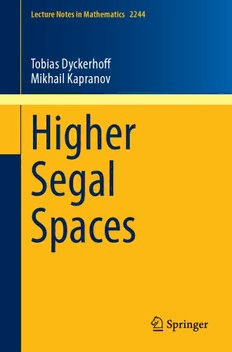Table Of ContentLecture Notes in Mathematics 2244
Tobias Dyckerhoff
Mikhail Kapranov
Higher
Segal
Spaces
Lecture Notes in Mathematics 2244
Editors-in-Chief:
Jean-MichelMorel,Cachan
BernardTeissier,Paris
AdvisoryEditors:
KarinBaur,Leeds
MichelBrion,Grenoble
CamilloDeLellis,Princeton
AlessioFigalli,Zurich
AnnetteHuber,Freiburg
DavarKhoshnevisan,SaltLakeCity
IoannisKontoyiannis,Cambridge
AngelaKunoth,Cologne
ArianeMézard,Paris
MarkPodolskij,Aarhus
SylviaSerfaty,NewYork
GabrieleVezzosi,Florence
AnnaWienhard,Heidelberg
Moreinformationaboutthisseriesathttp://www.springer.com/series/304
Tobias Dyckerhoff (cid:129) Mikhail Kapranov
Higher Segal Spaces
123
TobiasDyckerhoff MikhailKapranov
DepartmentofMathematics KavliInstituteforthePhysics
UniversityofHamburg andMathematicsoftheUniverse
Hamburg,Germany Kashiwa,Japan
ISSN0075-8434 ISSN1617-9692 (electronic)
LectureNotesinMathematics
ISBN978-3-030-27122-0 ISBN978-3-030-27124-4 (eBook)
https://doi.org/10.1007/978-3-030-27124-4
MathematicsSubjectClassification(2010):19D10,18G30,55U10,55U40,55U35,05E10,05E05
©SpringerNatureSwitzerlandAG2019
Thisworkissubjecttocopyright.AllrightsarereservedbythePublisher,whetherthewholeorpartof
thematerialisconcerned,specificallytherightsoftranslation,reprinting,reuseofillustrations,recitation,
broadcasting,reproductiononmicrofilmsorinanyotherphysicalway,andtransmissionorinformation
storageandretrieval,electronicadaptation,computersoftware,orbysimilarordissimilarmethodology
nowknownorhereafterdeveloped.
Theuseofgeneraldescriptivenames,registerednames,trademarks,servicemarks,etc.inthispublication
doesnotimply,evenintheabsenceofaspecificstatement,thatsuchnamesareexemptfromtherelevant
protectivelawsandregulationsandthereforefreeforgeneraluse.
Thepublisher,theauthors,andtheeditorsaresafetoassumethattheadviceandinformationinthisbook
arebelievedtobetrueandaccurateatthedateofpublication.Neitherthepublishernortheauthorsor
theeditorsgiveawarranty,expressorimplied,withrespecttothematerialcontainedhereinorforany
errorsoromissionsthatmayhavebeenmade.Thepublisherremainsneutralwithregardtojurisdictional
claimsinpublishedmapsandinstitutionalaffiliations.
ThisSpringerimprintispublishedbytheregisteredcompanySpringerNatureSwitzerlandAG.
Theregisteredcompanyaddressis:Gewerbestrasse11,6330Cham,Switzerland
Preface
Since the first draft of this text, which appeared in 2012 on the arXiv, the theory
of higher Segal spaces has been further developed in various directions by several
groups of authors. For the sake of avoiding confusions related to references to the
currenttext,thesecontributionswillnotbementionedinthemainbodyofthiswork.
However,wewouldliketopresentashortdescriptionofsomeofthesemorerecent
developments.
Our notion of a unital 2-Segal space has been introduced independently by
Gálvez-Carrillo,Kock,andTonksunderthenamedecompositionspace[GCKT18].
While the two notions are precisely equivalent to one another, the perspective on
these structures in loc. cit. is rather different from the one presented in this work:
whileourpointofviewislargelyinspiredbythetheoryofHallalgebras,thecore
goalofloc.cit.istoprovide asystematicstudyofincidence algebras and Möbius
inversion.
Structured 2-Segal spaces turned out to play an interesting role in categorified
state sum constructions for 2-dimensional topological field theories. The founda-
tions for this approach were laid in [DK15] and further developed by Stern in
[Ste16]. In [DK18], these techniques were applied to implement a 2-dimensional
proposalofKontsevichtodescribethetopologicalFukayacategoryofaSteinman-
ifoldvialocalizationtoasingularspine[Kon09].Kapranov-Schechtmanproposeto
studycategorifiedversionsofperversesheaves,so-calledperverseSchobers,which
are locally described by 2-Segal spaces. As explained in [DKSS19], these objects
canbeusedtodefinetopologicalFukayacategorieswithcoefficients.
In[Dyc18],a2-SegalperspectiveonGreen’stheoremisprovided.Theoperadic
characterization of unital 2-Segal sets in § 3.6 was clarified and generalized
to ∞-categories by Walde [Wal17]. Relative versions of the 2-Segal condition,
designed to produce modules over Hall algebras, were introduced and studied in
[Wal16,You18].Thedescriptionof2-Segalspacesasalgebrasinspans(§10,§11)
wasdescribedinmorenaturaltermsbyPenney[Pen17a]whoalsoconstructedlax
bialgebra structures in [Pen17b], leading to categorified versions of Green’s theo-
+
rem.IntheworkofBergner-Osorno-Ozornova-Rovelli-Scheimbauer[BOO 18a],it
isshownthatanyunital2-Segalsetcanbeconstructedbyasuitablegeneralizationof
v
vi Preface
theS-construction,andtheforthcomingworkbythesamegroupofauthorsshows
that the statement generalizes to simplicial spaces. A new characterization of 2-
+
Segalspacesbythe1-Segalpropertyoftheirsubdivisionwasprovenin[BOO 18b].
In[EJS18],theK-theoryandHallalgebraofmatroidsarestudied,basedonthe
notionofaproto-exactcategoryintroducedinthiswork.
The first series of examples of d-Segal spaces beyond d > 2 were provided
byPoguntke [Pog17].They ariseasnaturalhigher-dimensional analogs ofSegal’s
and Waldhausen’s constructions and underline the relevance of the higher Segal
conditions. In the context of stable ∞-categories, these constructions organize
into a categorified Dold-Kan correspondence [Dyc17] exhibiting the higher Segal
conditionsastruncationconditionsoncategorifiedcomplexes[DJ19].
Acknowledgements We would like to thank A. Goncharov, M. Groechenig, P.
Lowrey, J. Lurie, I. Moerdijk, P. Pandit, and B. Toën for useful discussions
which influenced our understanding of the subject. We further thank P. James, S.
Mozgovoy,T.Walde,andM.Youngforpointingoutinaccuraciesinearlierversions
of the draft. The first author was a Simons Postdoctoral Fellow while part of this
work was carried out. The research of the second author was partially supported
by an NSF grant, by the Max-Planck-Institut für Mathematik in Bonn, and by the
UniversitéParis13.ItwassupportedbytheWorldPremierInternationalResearch
CenterInitiative(WPI)andtheMEXT,Japan.
Hamburg,Germany TobiasDyckerhoff
Kashiwa,Japan MikhailKapranov
June2019
Contents
1 Preliminaries................................................................ 1
1.1 LimitsandKanExtensions .......................................... 1
1.2 SimplicialObjects.................................................... 2
1.3 HomotopyLimitsofDiagramsofSpaces........................... 4
2 Topological1-Segaland2-SegalSpaces.................................. 9
2.1 Topological1-SegalSpacesandHigherCategories................ 9
2.2 MembraneSpacesandGeneralizedSegalMaps.................... 12
2.3 2-SegalSpaces........................................................ 19
2.4 Proto-ExactCategoriesandtheWaldhausenS-Construction ...... 21
2.5 Unital2-Segalspaces ................................................ 25
2.6 TheHecke-WaldhausenSpaceandRelativeGroup
Cohomology.......................................................... 27
3 Discrete2-SegalSpaces .................................................... 31
3.1 Examples:Graphs,Bruhat-TitsComplexes......................... 31
3.2 TheTwistedCyclicNerve ........................................... 34
3.3 TheMultivaluedCategoryPointofView........................... 36
3.4 TheHallAlgebraofaDiscrete2-SegalSpace...................... 43
3.5 TheBicategoryPointofView ....................................... 46
3.6 TheOperadicPointofView ......................................... 52
3.7 Set-TheoreticSolutionsofthePentagonEquation ................. 58
3.8 Pseudo-HolomorphicPolygonsasa2-SegalSpace ................ 63
3.9 Birationally1-and2-SegalSemi-SimplicialSchemes............. 67
4 ModelCategoriesandBousfieldLocalization........................... 71
4.1 ConceptsfromModelCategoryTheory............................. 71
4.2 EnrichedModelCategories.......................................... 73
4.3 EnrichedBousfieldLocalization..................................... 78
4.4 HomotopyLimitsinModelCategories ............................. 81
vii
viii Contents
5 The1-Segaland2-SegalModelStructures .............................. 85
5.1 YonedaExtensionsandMembraneSpaces ......................... 85
5.2 1-Segaland2-SegalObjects......................................... 90
5.3 1-Segaland2-SegalModelStructures .............................. 92
6 ThePathSpaceCriterionfor2-SegalSpaces............................ 95
6.1 AugmentedSimplicialObjects ...................................... 95
6.2 PathSpaceAdjunctions.............................................. 96
6.3 ThePathSpaceCriterion ............................................ 100
6.4 ThePathSpaceCriterion:Semi-SimplicialCase................... 102
7 2-SegalSpacesfromHigherCategories.................................. 107
7.1 Quasi-Categoriesvs.Complete1-SegalSpaces .................... 107
7.2 Exact∞-Categories.................................................. 109
7.3 TheWaldhausenS-ConstructionofanExact∞-Category......... 111
7.4 Application:DerivedWaldhausenStacks........................... 115
7.5 TheCyclicBarConstructionofan∞-Category.................... 122
8 HallAlgebrasAssociatedto2-SegalSpaces ............................. 125
8.1 TheorieswithTransferandAssociatedHallAlgebras ............. 125
8.2 Groupoids:ClassicalHallandHeckeAlgebras..................... 128
8.3 Groupoids:GeneralizedHallandHeckeAlgebras ................. 133
8.4 ∞-Groupoids:DerivedHallAlgebras .............................. 142
8.5 Stacks:MotivicHallAlgebras....................................... 148
9 Hall(∞,2)-Categories..................................................... 153
9.1 HallMonoidalStructures ............................................ 153
9.2 SegalFibrationsand(∞,2)-Categories............................. 157
9.3 TheHall(∞,2)-Categoryofa2-SegalSpace...................... 161
10 An(∞,2)-CategoricalTheoryofSpans ................................. 169
10.1 SpansinKanComplexes............................................. 170
10.2 VerticalSpans ........................................................ 172
10.3 HorizontalSpans ..................................................... 194
10.4 Bispans................................................................ 198
11 2-SegalSpacesasMonadsinBispans .................................... 201
11.1 TheHigherHallMonad.............................................. 201
A Bicategories.................................................................. 209
References......................................................................... 213
Introduction
ThetheoryofSegalspaces,asintroducedbyC.Rezk[Rez01],hasitsrootsinthe
classical work of G. Segal [Seg74] where the notion of a (cid:2)-space is introduced
andusedtoexhibitvariousclassifyingspacesasinfiniteloopspaces.Rezk’swork
analyzes the role of Segal spaces as a model for the homotopy theory of (∞,1)-
categories. The concept of a Segal space can be motivated as follows. Given a
simplicialsetX,wehave,foreachn≥1,anaturalmap
f :X −→X × X × ···× X (0.1)
n n 1 X0 1 X0 X0 1
where the right-hand side is an n-fold fiber product. The condition that all maps
f be bijective is called Segal condition and a simplicial set which satisfies this
n
conditioniscalledSegal.Therelevanceofthisconditioncomesfromthefactthatit
characterizestheessentialimageofthefullyfaithfulfunctor
N:Cat →Set
(cid:3)
which takes a small category to its nerve. Given a Segal simplicial set X, we can
recover the corresponding category C: the set of objects is formed by the vertices
of X, and morphisms between a pair of objects are given by edges in X between
thecorrespondingpairofvertices.Theinvertibilityoff allowsustointerpretthe
2
diagram
(0.2)
as a composition law for C, while the bijectivity of f implies the associativity of
3
thislaw.OnecanviewthetheoryofSegal(simplicial)spacesasadevelopmentof
thisideainahomotopytheoreticframework,wheresimplicialsetsarereplacedby
simplicialspaces,fiberproductsbytheirhomotopyanalogs,andbijectionsbyweak
equivalences.Thisleadstoaweakernotionofcoherentassociativitywhichcanbe
usedtodescribecompositionlawsinhighercategories.
ix

